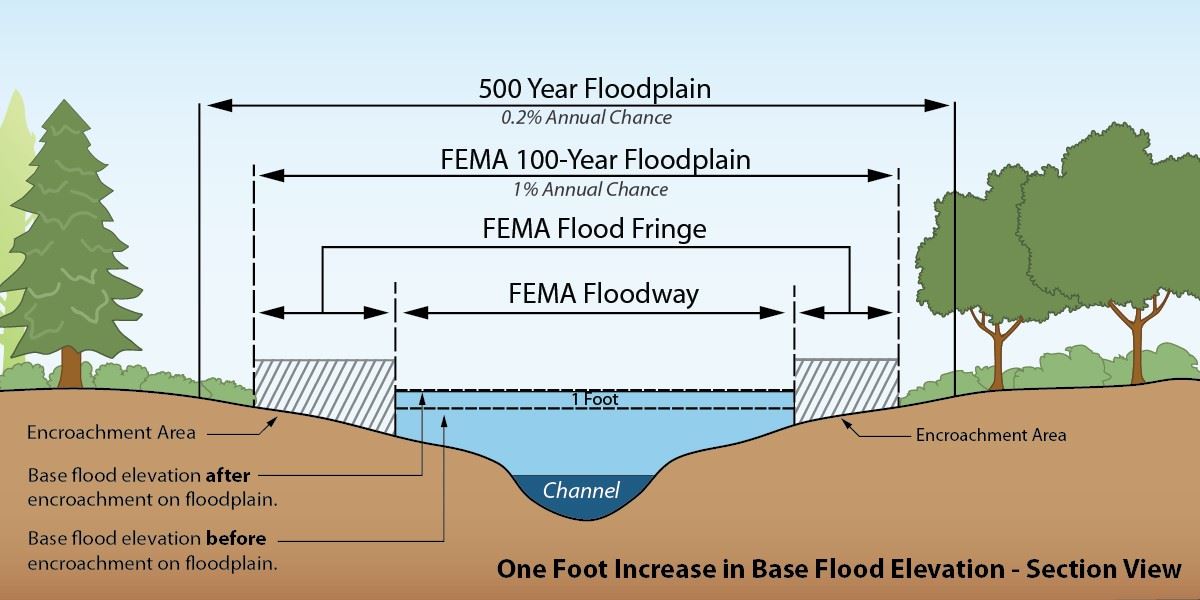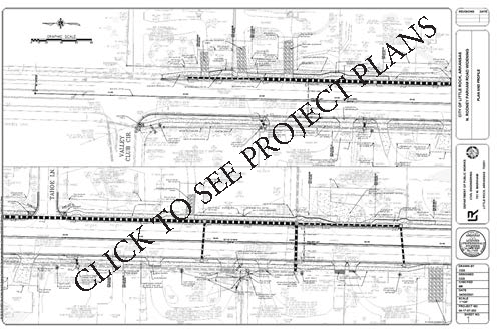Civil Engineering Division
Civil Engineering oversees design and construction of the City's infrastructure as well as providing information to the public and other city departments. Infrastructure includes streets, stormwater drainage facilities, and other capital improvements. Civil Engineering is divided into three (3) sections: 1) public projects; 2) private development; and 3) special programs.
Location
Civil Engineering offices are in the Public Works administration building located at 701 West Markham Street, Little Rock, Arkansas, 72201. Office hours are from 8:00 AM to 5:00 PM, Monday through Friday.
Public Projects Section
Public projects include streets, drainage, and other public facilities (exclusive of buildings) paid for by the City of Little Rock or other public funds and intended for public use. Private consultants or in-house personnel design publicly funded projects within the City. In addition to project design, this team is also responsible for land and right-of-way acquisition and bidding projects for construction. The staff land surveyor can sometimes assist with questions or concerns about right-of-way widths and locations.

Another team is responsible for administering the construction contracts and insuring the project is constructed as designed and in a timely manner.



North Rodney Parham
Road Reconstruction Project
This piece of grinding equipment extracts the pavement down to the base loading 15 cubic yards of material into the dump truck within about 3 minutes.

Franchise permits are issued for private use of public property such as outdoor dining on sidewalks and installing sprinklers or landscaping in the public right-of-way. Other work and uses within the public right-of-way is permitted through Traffic Engineering including utility and street work. associated with new development. A traffic control or barricade plan is required for this type of work.
For more details regarding the City of Little Rock's project designs and plans, please follow this link to the City of Little Rock Plan Development and Project Design Guidelines 2018. For Civil Engineering applications, details and manuals, please follow this link: Applications, Details and Manuals.
Approximately $170 million dollars has been allocated to Public Works since 2012 for capital improvements of streets, drainage, traffic signals, street resurfacing, sidewalks, and trails. For more details on current and recent capital improvement projects for streets and drainage, refer to the links shown below.
Sales Tax and Bond Projects by Wards 2013 - 2015
Sales Tax Projects by Wards 2016 - 2018
Sales Tax and Bond Projects by Wards 2019 - 2021
Bond Projects by Wards 2023 - 2025
Interactive Projects Map 2023 - 2025

Bond Project Status - Design Phase (Utility Coordination)
Street Condition Maps by Ward (Overview)
The Civil Engineering Division keeps a file of citizen requests for future projects. To have your project considered for future funding, fill out the online Infrastructure Project Request form. Please be aware funding allocations are seldom sufficient to fulfill all requests and that future capital improvement programs are subject to approval by the Little Rock Board of Directors.
-
Infrastructure Request Form for new Capital Projects (Online request form)
-
Infrastructure Request Form for new Capital Projects (Printable Fillable PDF version)



Stormwater Quality Management


Stormwater runoff is generated when precipitation from rain and snowmelt events flow over land or impervious surfaces and does not percolate into the ground. This surface runoff either flows into surface waters (creeks, rivers, lakes, etc.) or is channeled into storm sewer systems, which will carry the runoff to nearby waterbodies. Unlike sanitary discharges, storm water discharges are (in most cases) not treated. Stormwater has been shown to be one of the leading contributors to pollution of urban waterways, therefore certain stormwater discharges are regulated by the Environmental Protection Agency (EPA), the Clean Water Act (CWA) and the National Pollution Discharge Elimination System (NPDES).
Stormwater runoff can be managed through implementation of structural and non-structural controls, best management practices (BMPs) designed to control erosion and sediment transfer, and waste control measures. Public involvement and public education are important so that an understanding of stormwater control is gained.
Stormwater quality management refers to the development of programs, requirements, ordinances, policies and practices to preserve, enhance, and/or control the quality of stormwater runoff to reduce erosion and reduce the frequency and severity of flooding. Part of the City's mission is to educate the public and businesses on storm water quality management, pollution prevention, and to advise of permitting requirements respective to protecting our creeks, rivers, and lakes to improve our lifestyle, natural environment, and considerate use of water resources.
Municipal Separate Storm Sewer System (MS4) Stormwater Quality Management Permit
The Arkansas Department of Energy and Environment, Division of Environmental Quality (DEQ) has issued the City of Little Rock Stormwater Quality Management Permit (SWQMP), Permit Number ARS000002 to regulate storm water quality throughout its municipal separate storm sewer system (MS4). The Permit referred to as MS4 Permit under the NPDES and Arkansas Water and Air Pollution Control Act regulates municipal discharges from the Municipal Separate Storm Sewer System. Under this permit, the City of Little Rock, in tandem with the Arkansas Department of Transportation, have equal right and responsibilities of maintaining and managing stormwater quality throughout the City.
The Permit regulates stormwater quality through the six (6) minimum control measures as defined by EPA and subsequently DEQ:
- Public outreach and public education of stormwater quality impacts
- Public involvement and participation
- Illicit discharge detection and elimination
- Construction site stormwater runoff control
- Post-construction stormwater management in new development and redevelopment
- Good housekeeping for municipal operations
The Permit also establishes compliance, monitoring, record-keeping and reporting requirements for both co-permittees. The Permit was renewed by DEQ in 2020 where several small revisions were inserted to be incorporated into practice by the end of the Permit term.
Under the City’s MS4 Permit requirements, regular sampling of municipal stormwater discharge is conducted at several outfalls throughout the city. Samples are analyzed for known water quality parameters to assure pollutant levels stay below allowable limits to promote and preserve the health of local creeks, rivers and lakes. Sampling results must be periodically reported to EPA and Arkansas Department of Energy and Environment, Division of Environmental Quality (DEQ). City staff also conduct periodic inspections to ensure stormwater runoff from construction sites is controlled, as well as detect and investigate suspected illicit discharges.
Residents may report suspected illegal stormwater discharges, improper disposal and dumping by calling the City's non-emergency Reporting System (3-1-1) or using the free app developed for reporting.
The enforcement program utilizes the City's citation authority to ensure compliance and reinstatement of water quality in cases where direct intervention is necessary.
Stormwater Quality Management Program
The city has developed the Stormwater Quality Management Program to address all the requirements expressed in the MS4 Permit, to protect water quality and comply with federal and state requirements. The City of Little Rock’s Stormwater Quality Management Program is a comprehensive program consisting of various program elements and activities designed to reduce pollutants to the Maximum Extent Practicable (MEP) and eliminate prohibited non-stormwater discharges through NPDES municipal stormwater discharge permit.
Annual Report
The City of Little Rock, together with ARDOT provides annual compiled, detailed reports to DEQ to illustrate the efforts and progress made to comply with all the components of the MS4 Permit, according to prescribed control measures.
In addition to information gathered by various City departments, the City conducts its own stormwater discharge monitoring and analysis through its five (5) permitted outfalls, the result of which is explained and interpreted in the Annual Report.
The Annual Report provides data and interpretation of continued efforts, progress, and development in all aspects of stormwater management.
Annual Reports are due by April 1st of each year.
Helpful Links for more information on stormwater Quality management
- EPA Clean Water Act - epa.gov laws-regulations summary-clean-water-act
- NPDS Permit Requirements - adeq.state.ar.us water permits NPDES
- ARDOT Stormwater Management website - ardot.gov divisions environmental natural-resources stormwater-welcome-page
- Information for proper disposal of household hazardous waste and motor vehicle fluid - Pulaski County Regional Solid Waste Management District (PCRSWMD) regionalrecycling.org
- City of Little Rock stormwater management brochures Commercial construction - Commercial construction
- Residential construction - Residential construction
- Household hazardous waste - Household hazardous waste
- PAGIS - Stormwater Web Mapping Application
- Drain Smart - engaging public-education
Industrial Stormwater Discharge Monitoring Program
DEQ renewed the City's Stormwater Discharge Permit in 2020.
The renewed Permit includes a new compliance requirement component: "the City of Little Rock shall develop and implement a program to control pollutants in stormwater discharges to the MS4 (municipal separate storm sewer system) from industrial facilities through ordinance, permit , contract, order or similar means, in accordance with 40CFR Part 122.26(d)(2)(i)(A)."
Compliance with this new requirement has four (4) components:
- Develop and maintain an inventory of industrial facilities which comply with specific requirements listed in the Permit. Industrial facilities which are subject to the inspection program are inventoried by DEQ and referenced by Standard Industrial Classification (SIC) codes. Industries are mapped by location, with identifying information.
- Develop an inspection program of the above listed industrial facilities. The purpose of the industrial inspection program is to ensure facilities have obtained and maintained current and valid stormwater discharge permit coverage(s) from the DEQ and are actively implementing and maintaining control measures and best management practices (BMPs) to prevent the discharge of stormwater impacted by industrial chemicals or processes. Inspections further ensure that facilities are following their current Storm Water Pollution Prevention Plan (SWPPP), no unreported discharge violation(s) are occurring, and/or to ensure corrective action plans are being implemented. Prior to any inspections, the City will issue an Industrial Notice of Inspection, Document Submittal Request and provide general site inspection procedures. Following the inspection, results and findings will be compiled in a Summary of Findings which will be sent to each industrial facility visited.
- To ensure any violations found during inspections are corrected, the city is required to develop an enforcement program. The enforcement program is designed to ensure any permit-specific violations observed are documented and corrected. If violations are found at an inspected facility, the affected facilities are required to develop a Corrective Action Plan with activities and a timetable detailing the scheduling of actions to mitigate pollutant discharges. The schedule shall contain progress increments leading to permit compliance.
- To the extent possible, the City will ensure industrial facilities are conducting regular monitoring of their stormwater The city can also request additional monitoring if pollutants are detected.
Citizen Involvements in Stormwater Quality Management
Allowable non-stormwater discharges
Municipal Codes (Sec. 29.45) provide guidance for non-stormwater discharges into the municipal storm sewer system:
- Water line flushing
- Landscape irrigation
- Diverted stream flows
- Rising ground water
- Uncontaminated ground water infiltration as defined at 40 CFR 35.2005(20) to separate storm sewers
- uncontaminated pumped ground water
- Discharges from potable water sources
- Foundation drains
- Air conditioning condensate
- Irrigation water
- Springs
- Water from crawl space pumps
- Footing drains
- Lawn watering
- Individual residential car washing
- Flows from Riparian habitats and wetlands
- Dechlorinated swimming pool discharges
- Street wash water and
Discharges or flows from emergency firefighting activities.
Floatable Reduction Programs
The following initiatives aim to reduce the volume of trash and other floatable contaminants that end up in our waterways and bring attention to the importance of preventing debris and other floatable matters being washed into the storm water system.
Drain Smart
Drain Smart is a program that is intended to engage the general public and express the importance of protecting our environment through captivating street art mural pieces by local artists. Artwork highlights the importance of being aware of the impacts of humans on our environment. The program aims to communicate the function and importance of the local storm sewer system and why the quality of stormwater matters.


Drain Smart - engaging public-education
Floodplain Management
The Civil Engineering Division administers oversight of development permits for excavation and construction on properties located in the floodplain for the Citizens of the City of Little Rock. The Division also provides information on the City of Little Rock special flood-hazard area (SFHA) and basic flood insurance information, such as base flood elevations, floodways, historical flooding, and known flooding depths.
The City of Little Rock "Flooding Awareness” brochure and the FEMA National Flood Insurance Program (NFIP) found at floodsmart.gov are additional sources of floodplain service information.
Property owners can also access Little Rock digital floodplain maps and FEMA flood insurance rate maps (FIRMs) using the Web Application hosted by PAGIS - Flood Zone Map App. For questions and additional information about floodplain regulations and development in the City of Little Rock, you may contact the City of Little Rock Floodplain Manager at (501) 371-4823.

Special Programs Section
The Special Programs Section of Public Works is primarily responsible for providing information to citizens, other divisions of Public Works, and other City Departments. Special Programs includes Mapping & Graphics, Geographic Information Services, and Public Information.
Address Assignment & Mapping
Mapping & Graphics maintains up-to-date maps of the City of Little Rock. These maps include, but are not limited to, information on City limits, the City street system, subdivision properties, annexation, and capital improvement projects.
The Street Index Book is useful for locating any City street within Little Rock and is revised annually.
Our Addressing Specialist has the responsibility for street address assignments as well as approving new street names. Addresses are assigned to new buildings based on a grid, referenced from the intersection of Markham and Main Streets in downtown Little Rock. Both correct address assignment and review of new street names are crucial for accurate dispatching of 911 services.
Utilizing our robust set of web mapping applications is the most efficient way of accessing mapping data along with various digital Adobe PDF versions of certain map products.
CITY of LITTLE ROCK ONLINE MAPPING APPLICATIONS
PAGIS ONLINE MAPPING APPLICATIONS
Adopt-A-Street


The Public Works Department administers the Adopt-A-Street Program in partnership with Keep Little Rock Beautiful (KLRB). Adopt-A-Street is a program in which neighborhoods, businesses, or individuals can "adopt" a street and pledge to keep streets clean by picking up litter along their adopted street at least four (4) times a year.

The Adopt-A-Street Program has many available streets for adoption and provides a valuable service for our community, affording a great opportunity for citizen and group involvement. This type of opportunity promotes a sense of civic pride as you become an active participant in the effort to make Little Rock a beautiful city we can all enjoy. You can find more information about joining the Adopt-A-Street Program here.
Geographic Information Services (GIS)
GIS provides geographical representation of data in the City of Little Rock with a computer mapping system. GIS uses a graphical database representing most features that can be seen in aerial photography. This is used with other records and databases containing information about such things as the City's demographics, locations of various buildings, Police and Fire districts, and infrastructure for mapping and analysis related to needs of the City of Little Rock.
Much of this information is now easily accessible through Online Web Based Applications from the following link to the main page. Applications such as these bring a great deal of information straight to the Citizens of Little Rock in an interactive format which if fairly simple to navigate.
CITY of LITTLE ROCK ONLINE MAPPING APPLICATIONS
GIS has proven to be a useful management tool and allows Public Works to easily produce a large quantity of specialized information about the City of Little Rock. Public Works is a founding member of PAGIS, the Pulaski Area Geographic Information System, a countywide consortium with mutual interests in operation of a GIS.

PAGIS has many useful online interactive mapping applications on their website.
PAGIS ONLINE MAPPING APPLICATIONS
Some of these are Land Ownership, Water and Waste Water Utilities, Flood Mapping, Parks and Trail Systems, and the Storm Water System Application.
Public Information
Special Programs coordinates public information programs for the Public Works Department. Information about Public Works services is disseminated to citizens and community groups facilitating a better understanding of Public Works, and encouraging citizens to use the wealth of resources the Department has to offer. Brochures and informational packets, both in printed form and online, are a few of the tools used for customer relations and public information.
Historical Information
Our Historical City
Original City Historical Firsts Illustrated
For More Information
David Hopkins, P.E., Manager
Civil Engineering Division
701 West Markham Street
Little Rock, AR 72201
Office: (501) 371-4811
For General Public Works Service Requests
Public Works Service Requests and other general information, please call the City's non-emergency number 3-1-1. You may also access 311 through the Citizen Portal directly online.
Contact Numbers
| Civil Engineering/Division Manager 701 West Markham Street 72201 |
(501) 371-4811 |
| Address Verification & City Limits | (501) 371-4537 |
| Adopt-A-Street | (501) 371-4714 |
| Floodplain/Stormwater Management | (501) 371-4817 |
| Public Improvement Projects | (501) 371-4820 |
| Special Programs | (501) 371-4714 |
Email: PublicWorks@littlerock.gov




 Trash & Recycling
Trash & Recycling
 Online Payments
Online Payments
 City Documents
City Documents
 Parks
Parks
 Traffic Court
Traffic Court
 E-NEWS
E-NEWS
 EXPLORE
EXPLORE
 NEWS
NEWS
 TRANSLATE
TRANSLATE



